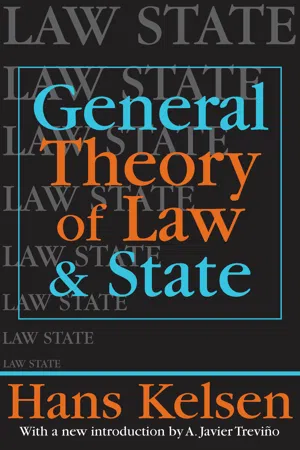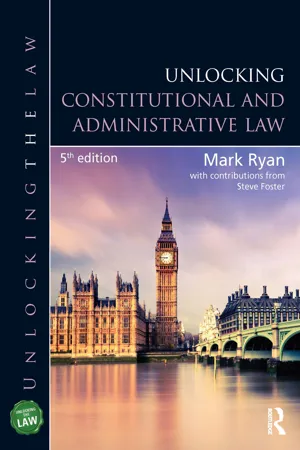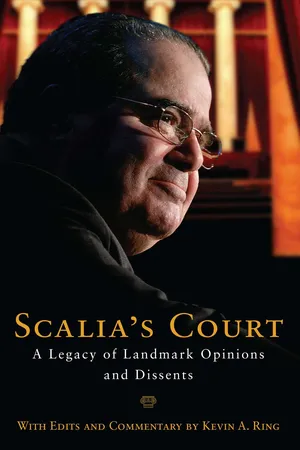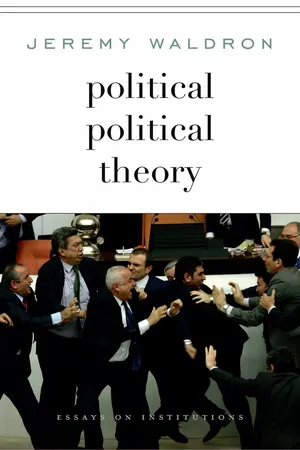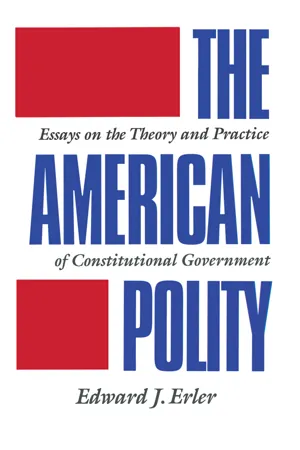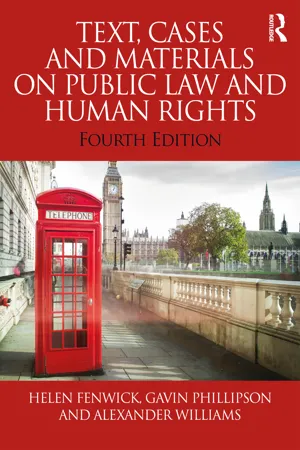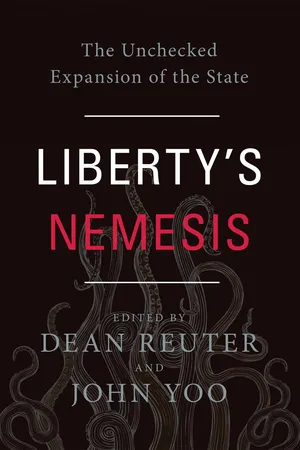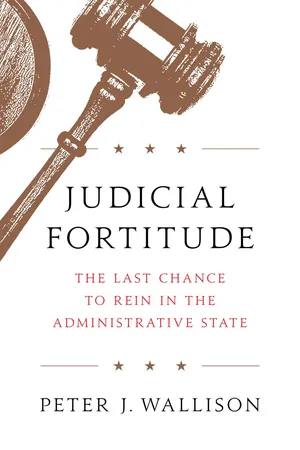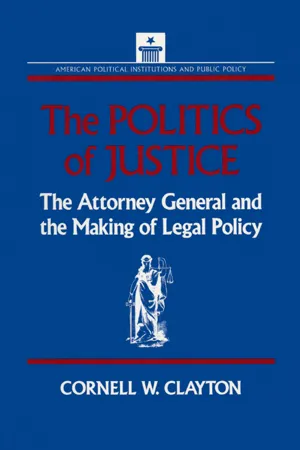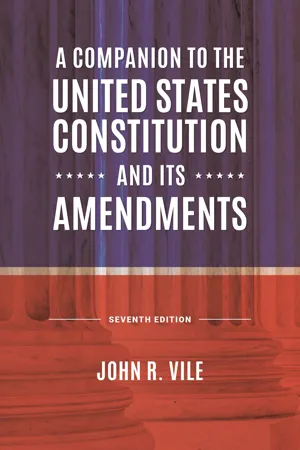Law
Separation of Powers USA
The Separation of Powers in the USA refers to the division of governmental responsibilities among the executive, legislative, and judicial branches. This system aims to prevent the concentration of power in any one branch and to provide a system of checks and balances. It is a fundamental principle of the US Constitution, designed to safeguard against tyranny and ensure accountability.
Written by Perlego with AI-assistance
Related key terms
12 Key excerpts on "Separation of Powers USA"
- eBook - ePub
- Hans Kelsen(Author)
- 2017(Publication Date)
- Routledge(Publisher)
III. The Separation of PowersA. The Concept of “Separation of powers”
The judicial review of legislation is an obvious encroachment upon the principle of separation of powers. This principle lies at the basis of the American Constitution and is considered to be a specific element of democracy. It has been formulated as follows by the Supreme Court of the United States: “that all the powers intrusted to government, whether State or national, are divided into the three grand departments, the executive, the legislative and the judicial. That the functions appropriate to each of these branches of government shall be vested in a separate body of public servants, and that the perfection of the system requires that the lines which separate and divide these departments shall be broadly and clearly defined. It is also essential to the successful working of this system that the persons intrusted with power in any one of these branches shall not be permitted to encroach upon the powers confided to the others, but that each shall by the law of its creation be limited to the exercise of the powers appropriate to its own department and no other.”†The concept of “separation of powers” designates a principle of political organization. It presupposes that the three so-called powers can be determined as three distinct coordinated functions of the State, and that it is possible to define boundary lines separating each of these three functions from the others. But this presupposition is not borne out by the facts. As we have seen, there are not three but two basic functions of the State: creation and application (execution) of law, and these functions are not coordinated but sub- and supra-ordinated. Further, it is not possible to define boundary lines separating these functions from each other, since the distinction between creation and application of law — underlying the dualism of legislative and executive power (in the broadest sense) — has only a relative character, most acts of State being at the same time law-creating and law-applying acts. It is impossible to assign the creation of law to one organ and the application (execution) of law to another so exclusively that no organ would fulfill both functions simultaneously. It is hardly possible, and at any rate not desirable, to reserve even legislation — which is only a certain kind of law-creation — to a “separate body of public servants” and to exclude all the other organs from this function. - eBook - ePub
The Impossible State
Islam, Politics, and Modernity's Moral Predicament
- Wael Hallaq(Author)
- 2012(Publication Date)
- Columbia University Press(Publisher)
3 Separation of Powers Rule of Law or Rule of the State?The pure doctrine of the separation of powers is based on the view that there are three functions of government: to give laws, to implement the laws and to interpret the laws. To each of the three functions corresponds a branch of government: laws are given by a legislature, implemented by an executive and interpreted by a judiciary. . . . The doctrine . . . has become so riddled with exceptions that it must be scrapped.—Mogens Hansen, “The Mixed Constitution Versus the Separation of Powers”Still, we cannot seem to solve the problem of separation of powers. We are not even close. We do not agree on what the principle requires, what its objectives are, or how it does or could accomplish its objectives.—M. Elizabeth Magill, “Real Separation in Separation of Powers”The post–New Deal administrative state is unconstitutional, and its validation by the legal system amounts to nothing less than a bloodless constitutional revolution. . . . The destruction of this principle of separation of powers is perhaps the crowning jewel of the modern administrative revolution. Administrative agencies routinely combine all three governmental functions in the same body, and even in the same people within that body.—Gary Lawson, “Rise and Rise of the Administrative State” From nearly the start of the American republic, the separation of powers as the Framers understood it, and as contemporary constitutional law continues to understand it, had ceased to exist. —Daryl J. Levinson, “Separation of Parties, Not Powers”Because we rightly believe in the basic ideal of democracy we feel usually bound to defend the particular institutions which have been for long accepted as its embodiment, and hesitate to criticize them because this might weaken the respect for an ideal we wish to preserve. . . . It seems to me that the disillusionment which so many experience is not due to a failure of the principle of democracy as such but to our having tried it in the wrong way. - eBook - ePub
- Mark Ryan, Steve Foster(Authors)
- 2023(Publication Date)
- Routledge(Publisher)
Under a partial separation of powers the objective is to avoid a concentration of power. This is achieved not by an absolute separation and isolation of the three functions, but instead through the creation of a number of checks and balances between them. In other words, one institution may well interfere with the (constitutional) function of another. For example, in the Republic of Ireland, the Oireachtas as the legislature is responsible for enacting laws. Under Art 34 of the Irish Constitution, however, the Irish Supreme Court may declare legislation legally unconstitutional and therefore null and void. Moreover, under Art 26 the President of Ireland (a formal and typically ceremonial aspect of the executive) may refer a Bill that has not yet been signed (and so yet to become an Act) to the Supreme Court in order to determine whether or not it is unconstitutional. If the Bill, or any part of it, is deemed unconstitutional, the Bill cannot become law. This therefore frustrates the legislature in its function of law-making.Similarly, the doctrine of the separation of powers is clearly evident in the United States Constitution as it is based on a subtle set of checks and balances. For instance, the President (executive) can, temporarily at least, check the legislature in the context of legislation by vetoing a Bill which has successfully passed through Congress. Ultimately, however, the latter can overturn the presidential veto by a two-thirds majority in each House. In addition, in terms of appointments to the Supreme Court, the Senate (the second chamber of Congress) must confirm a presidential nomination (an executive decision) of a proposed justice of the Supreme Court.5.5.3 To provide efficient government
At one level the doctrine of the separation of powers helps to achieve efficient government. In short, allocating definite functions to specific institutions staffed with particular expertise (eg government which is expert at administering and the judiciary which is expert at assessing evidence and judging), necessarily provides efficient government.5.5.4 To safeguard the independence of the judiciary
The separation of powers subsumes the fundamental notion that the judiciary should be constitutionally independent. In a democratic constitution it is of paramount importance that the judges – who form part of the court system – are independent, impartial and free from interference from the other branches of the state (and in particular the executive). The principle of the independence of the judiciary embraces, inter alia, the notion that the judiciary must be free to determine disputes before them strictly in accordance with the law (see Chapter 13 - eBook - ePub
Scalia's Court
A Legacy of Landmark Opinions and Dissents
- Antonin Scalia, Kevin A. Ring, Kevin A. Ring(Authors)
- 2016(Publication Date)
- Regnery(Publisher)
CHAPTER THREE SEPARATION OF POWERST HE CONSTITUTION OF THE UNITED STATES established three distinct branches of the federal government—the executive, the legislative, and the judicial. With this clear division of power between the branches in place, and fortified by the division of power between the federal government and states (a.k.a. federalism), “a double security arises,” James Madison wrote, for the vital purpose of protecting “the rights of the people.”1 Far from serving as a simple housekeeping list of functions of the three branches, the Constitution’s separation of powers is necessary to protect individual liberty by keeping the power of government in check.Many judges today approach separation of powers questions from a practical standpoint. These judges, sometimes referred to as “functionalists,” look at the overall balance of federal power before determining whether one branch has usurped too much power.2 For example, the Court ruled in 1989 that creation of the U.S. Sentencing Commission—an entity in which federal judges are authorized to act in an executive policymaking capacity—did not violate the independent authority of the judiciary under Article III of the Constitution.3Justice Scalia dissented from the Court’s decision in that case and squarely rejected the functional approach to separation-of-powers questions. Instead, he tried to maintain clear lines. In his view, the Constitution did not allow for the branches to “share” authority specifically given to one branch. Not a little, not at all. His separation-of-powers opinions tended to be long, filled with references to the Framers’ objectives in dividing power as they did, and sprinkled with pointed warnings about the harmful consequences of allowing power to be commingled. - eBook - ePub
- Jeremy Waldron(Author)
- 2016(Publication Date)
- Harvard University Press(Publisher)
CHAPTER THREESeparation of Powers and the Rule of LawMY TOPIC FOR this chapter is the separation of powers, conceived as a political principle for evaluating the legal and constitutional arrangements of a modern state. What is this principle, and why is it important? The question takes us in interesting directions if we distinguish the separation of powers from a couple of other important constitutional ideas that are commonly associated with it. The first of these is the principle of the dispersal of power—a principle that counsels us to avoid excessive concentrations of political power in the hands of any one person, group, or agency. The second is the principle of checks and balances—a principle that holds that the exercise of power by any one power-holder needs to be balanced and checked by the exercise of power by other power-holders. Does the principle of the separation of powers have any meaning over and above these two principles? I think it does, and in this chapter I want to explore aspects of the separation of powers that are independent of what we value in these two other principles.The separation of powers counsels a qualitative separation of the different functions of government—for example, legislation, adjudication, and executive administration. But the justification for this separation is not made clear in the canonical literature of seventeenth- and eighteenth-century political theory: Montesquieu’s “justifications,” for example, were mostly tautologies.1 And in the spirit of those tautologies, modern constitutionalism has, until recently, taken the separation of powers for granted. I mean it takes for granted that the separation of powers is necessary to avoid tyranny, but it does not explain why. I think a qualitative separation is - eBook - ePub
The American Polity
Essays On The Theory And Practice Of Constitutional Government
- Edward J. Erler(Author)
- 2013(Publication Date)
- Routledge(Publisher)
Chapter Four The Separation of Powers in the Administrative State“But because those Laws which are constantly to be Executed, and whose force is always to continue, may be made in little time; therefore there is no need, that the Legislative should be always in being, not having always business to do. And because it may be too great a temptation to humane frailty apt to grasp at Power, for the same Persons who have the Power of making Laws, to have also in their hands the power to execute them, whereby they may exempt themselves from Obedience to the Laws they make, and suit the Law, both in its making and execution, to their own private advantage, and thereby come to have a distinct interest from the rest of the Community, contrary to end of Society and Government.”—John Locke1“If there is a principle in our Constitution, indeed in any free Constitution more sacred than another, it is that which separates the legislative, executive and judicial powers. If there is any point in which the separation of the legislative and executive powers ought to be maintained with great caution, it is that which relates to officers and offices.”—James Madison2Throughout American history, the separation of powers doctrine has indeed been held almost as a “sacred principle” of constitutional government. There have been, of course, many disputes about the precise configuration of the separated powers3 but rarely any doubts about the efficacy of the principle itself. Today, however, the principle is vigorously challenged in the name of efficient government—or more precisely, in the name of the administrative state. As one political scientist has remarked, “[t]he fundamental problem, in trying to make the government of the United States work effectively, is not to preserve the separation of powers but to overcome it. For anything of consequence to be accomplished, the executive and legislative branches must be brought from confrontation into a reasonable degree of harmony … [Confrontation, stalemate and deadlock … frequently leave the government of the United States impotent to cope with complex problems.”4 - Helen Fenwick, Gavin Phillipson, Alexander Williams(Authors)
- 2020(Publication Date)
- Routledge(Publisher)
The argument in the previous section has shown that the Separation of Powers should not be explained in terms of a strict distribution of functions between the three branches of government, but in terms of a network of rules and principles which ensure that power is not concentrated in the hands of one branch … That does not mean that the allocation of functions is wholly irrelevant … But the importance of a correct definition and allocation of functions should not be exaggerated. Madison for instance was not troubled by these questions, though nobody has argued so cogently for the Separation of Powers principle.Outside the context of court rulings in civil liberties cases, the principle is most frequently applied in the architecture of the constitution itself. Powers are allocated to different institutions. The legislature is normally divided into two branches, a procedure recommended by Madison on the ground that otherwise it would be too powerful [Federalist Papers, No 51]. Each branch is empowered to check the others by exercising a partial agency or control over their acts [ibid, No 47]. That is why, for example, in the US constitution the Senate must give its advice and consent to the appointment of ministers, ambassadors and judges, and the President may veto Bills passed by the House of Representatives and the Senate, subject to an override by a two-thirds majority vote in each House. It is not very helpful to ask whether, in the former instance, the Senate is exercising an executive power and whether, in the latter, the President acts as a third branch of the legislature. What is important is that there is a system of checks and balances between institutions which otherwise might exercise excessive power. As Madison put it in Federalist Paper 51, the structure of government should be so arranged ‘that its several constituent parts may, by their mutual relations, be the means of keeping each other in their proper places’.Note
It was noted in Chapter 1 (p 13) that the provisions in different constitutions dealing with relations between the executive and legislature show far more variation than those governing the independence of the judiciary. Indeed, the one part of the separation of powers doctrine that does- eBook - ePub
Liberty's Nemesis
The Unchecked Expansion of the State
- Dean Reuter, John Yoo(Authors)
- 2016(Publication Date)
- Encounter Books(Publisher)
18. THE SEPARATION OF POWERS IN AN ADMINISTRATIVE STATEDavid McIntosh and William J. HaunWhen Americans are asked about the “most important” part of our Constitution—the truly indispensable guarantee within it—they usually cite the provisions within the Bill of Rights. That answer, however, is not the founders’. As James Madison noted in Federalist No. 47, “[n]o political truth is certainly of greater intrinsic value, or is stamped with the authority of more enlightened patrons of liberty,” than the need for separated governmental power.1 While, as Justice Scalia frequently puts it, “[e]very banana republic has a bill of rights,”2 the separation of executive, legislative, and judicial authority into coordinate branches prohibits any one government actor from exercising total power—what the Federalist characterized as “the very definition of tyranny.”3With such high stakes, the threat modern regulatory agencies pose to the separation of powers cannot be ignored. Modern regulatory agencies effectively exercise the entire range of governmental power—legislative, executive, and judicial.4 Their function is as threatening as their scope: many agencies write law through rulemaking, enforce it—increasingly with armed police—and then adjudicate it with an administrative law judge (ALJ) who works for the agency.The modern administrative state was founded on premises that supplant the separation of powers. These premises—that agencies staffed with “experts” will face “modern” problems better than elected officials and that administration is more “efficient” than legislating—still undergird agency operations today. The three constitutional branches have engaged in a gradual surrender of power to the administrative state. This essay strives to outline this problem and propose solutions that can both (1) restore current administrative power to the appropriate constitutional branch and (2) impose separation-of-powers principles on agency actions and procedures. As Justice Scalia noted in his seminal dissent in Morrison v. Olson, “just as the mere words of the Bill of Rights are not self-effectuating, the Framers recognized ‘[t]he insufficiency of a mere parchment delineation of the boundaries’ to achieve the separation of powers.”5 - eBook - ePub
Judicial Fortitude
The Last Chance to Rein In the Administrative State
- Peter J. Wallison(Author)
- 2018(Publication Date)
- Encounter Books(Publisher)
2THE SEPARATION OF POWERS AND CHECKS AND BALANCESWhen courts refuse even to decide what the best interpretation is under the law, they abandon the judicial check. That abandonment permits precisely the accumulation of governmental powers that the Framers warned against.JUSTICE CLARENCE THOMAS 1O nly the United States, among large and developed countries, has a written constitution that divides its government into three distinct parts—a Congress with responsibilities for legislation, a president to execute the laws, and a judiciary to interpret the laws. The Framers seem to have had two reasons for this complex structure. First, as always, was the paramount goal of preserving liberty for the American people: the Framers’ central stated purpose was to make it as difficult as possible for the government to threaten these freedoms. In Federalist No. 47, Madison states the Framers’ theory starkly: “The accumulation of all powers, legislative, executive and judiciary, in the same hands … may justly be pronounced the very definition of tyranny.”But there was a second objective, somewhat different from the first: how to assure that the government did not, over time—despite the words of the Constitution—become the tyranny that the Framers feared. This they hoped to avoid by giving each of the branches an opportunity, in pursuing its own interests, to check the powers of the others. The president, for example, can veto legislation enacted by Congress; Congress has the power to confirm the top officers of the executive branch and to appropriate funds for both the executive and the judiciary; and the judiciary can assure that the other branches are staying in their assigned constitutional lanes. In Federalist - eBook - ePub
The Administrative State
A Study of the Political Theory of American Public Administration
- Dwight Waldo(Author)
- 2017(Publication Date)
- Routledge(Publisher)
Chapter 7THE SEPARATION OF POWERS 1The problem of separation of powers has been of prominent and continuing interest to administrative writers. In fact, they have given this problem more attention during the past fifty years than have writers on "political theory."The reasons for this are not far to seek. Separation of powers into three "branches" was an outstanding characteristic of our national, state, and even municipal governments during the nineteenth century. We had, moreover, a strong public consciousness of the separation of powers and an inclination to regard it as a prime virtue of our superior institutions, a "palladium of our liberties." 2 But by the year of Woodrow Wilson’s essay, "The Study of Administration," there was already under way a great expansion of governmental activities. This expansion upset old balances, raised questions of the appositeness of the old theory. At the federal level the creation of "independent establishments," beginning in 1883, and at the state and local levels the extreme decentralization of "executive" power, raised a presumption that the "tripartite theory" was being violated, that it should either be reapplied, or else be modified or abandoned. The separation of powers was writ so large in American practice and thought that students of public administration could not have avoided a conscious, serious treatment of the subject. The resulting literature is vast and disparate. There are recognizable motifs, but many variations on the themes, and some widely varying, indeed contrary, opinions. Some of the writing is of a quality with the Federalist papers; all of it is interesting, even when, as occasionally it must be, frivolous.The Current of Reform
Generally speaking, students of administration have been hostile to the tripartite separation of powers. In this they have not been alone; their hostility must be viewed against the background of almost complete lack of sympathy for the principle by American reformism and political science. This lack of sympathy became more widespread decade by decade between the Civil War and the First Great War.3 - eBook - ePub
The Politics of Justice
Attorney General and the Making of Government Legal Policy
- Cornell W. Clayton(Author)
- 2015(Publication Date)
- Routledge(Publisher)
Not only did the system empower each branch to defend itself against attacks from the others, it locked the three together, forcing them to cooperate. In an often quoted concurring opinion, Justice Robert H. Jackson noted: “the Constitution diffuses power the better to secure liberty”; it also predicts that “practice will integrate the dispersed powers into a workable government.” The Constitution, he continued, requires “interdependence and reciprocity” as well as “separateness and autonomy.” 18 From the time of the Constitution’s ratification, debate has been waged as to whether the separation of powers requires a “hermetic sealing off” of the three branches of government outside of the express checks and balances. 19 Even the Supreme Court has vacillated between a “formalistic” view demanding the strict separation of “three unitary, airtight departments,” and a “functionalistic” view that allows greater flexibility and blending of functions between departments. 20 Nowhere is the Court’s ambivalence more apparent than in its decisions regarding control of the administrative bureaucracy. Under the traditional “organizational chart” approach to the separation of powers, the crucible comes in cases over the removal of subordinate officers; power to remove is seen as power to control. When the issue initially surfaced in American politics, the Supreme Court ruled that removal authority was inherent in appointment authority; the latter gave rise to the former. Under the Constitution, principal officers of the United States must be appointed by the President with the advice and consent of the Senate. Congress may, however, “vest the appointment of such inferior Officers, as they think proper, in the President alone, in the Courts of Law, or in the Heads of the Departments.” 21 In an early case, Ex Parte Hennen (1839), the Court was asked to decide whether Congress could grant the judiciary the power to appoint and remove court clerks - John R. Vile(Author)
- 2021(Publication Date)
- Praeger(Publisher)
The text of the Constitution consists of seven articles, most of which are subdivided into sections. Although the Constitution does not employ the specific phrase, the structure of the document reflects the doctrine of separation of powers. Thus the first three articles of the Constitution establish separate branches of the central or national government. Article I creates the legislative branch, Article II the executive branch, and Article III the judicial branch.This order is purposeful and instructive. Because they were creating a democratic, or representative, government that rested on what the Declaration of Independence called “the consent of the governed” and what the Constitution simply refers to as “We the People,” the authors of the Constitution logically began with the two branches that the people elected and then proceeded to the branch that the president appointed and that the Senate confirmed.This chapter focuses on Article I, which chiefly establishes and outlines the powers and limits of the legislative branch. Article I, Section 1. All legislative Powers herein granted shall be vested in a Congress of the United States, The Priority of the Legislative BranchThe legislative branch had been the only branch of government under the Articles of Confederation. It was the first branch that delegates discussed at any length at the Constitutional Convention, and most of the delegates thought that it would continue to be the most powerful. The framers refused to entrust Congress—any more than the British Parliament—with complete sovereignty but limited it to exercising legislative powers “herein granted.”By vesting “legislative powers” in Congress (the first clauses of each of the first three Articles of the Constitution are often called vesting clauses), the Constitution limited the powers that it could delegate to the other branches. Schechter Poultry Corporation v. United States (1935) provided one of the best examples of this limitation. Congress had, under the National Industrial Recovery Act of 1933, allowed individual industries to establish binding codes of fair competition subject only to presidential approval. The Supreme Court invalidated this massive delegation of powers. However, the Supreme Court has generally been more generous in upholding congressional delegations of power in the area of foreign affairs. In United States v. Curtiss-Wright Export Corp.
Index pages curate the most relevant extracts from our library of academic textbooks. They’ve been created using an in-house natural language model (NLM), each adding context and meaning to key research topics.
